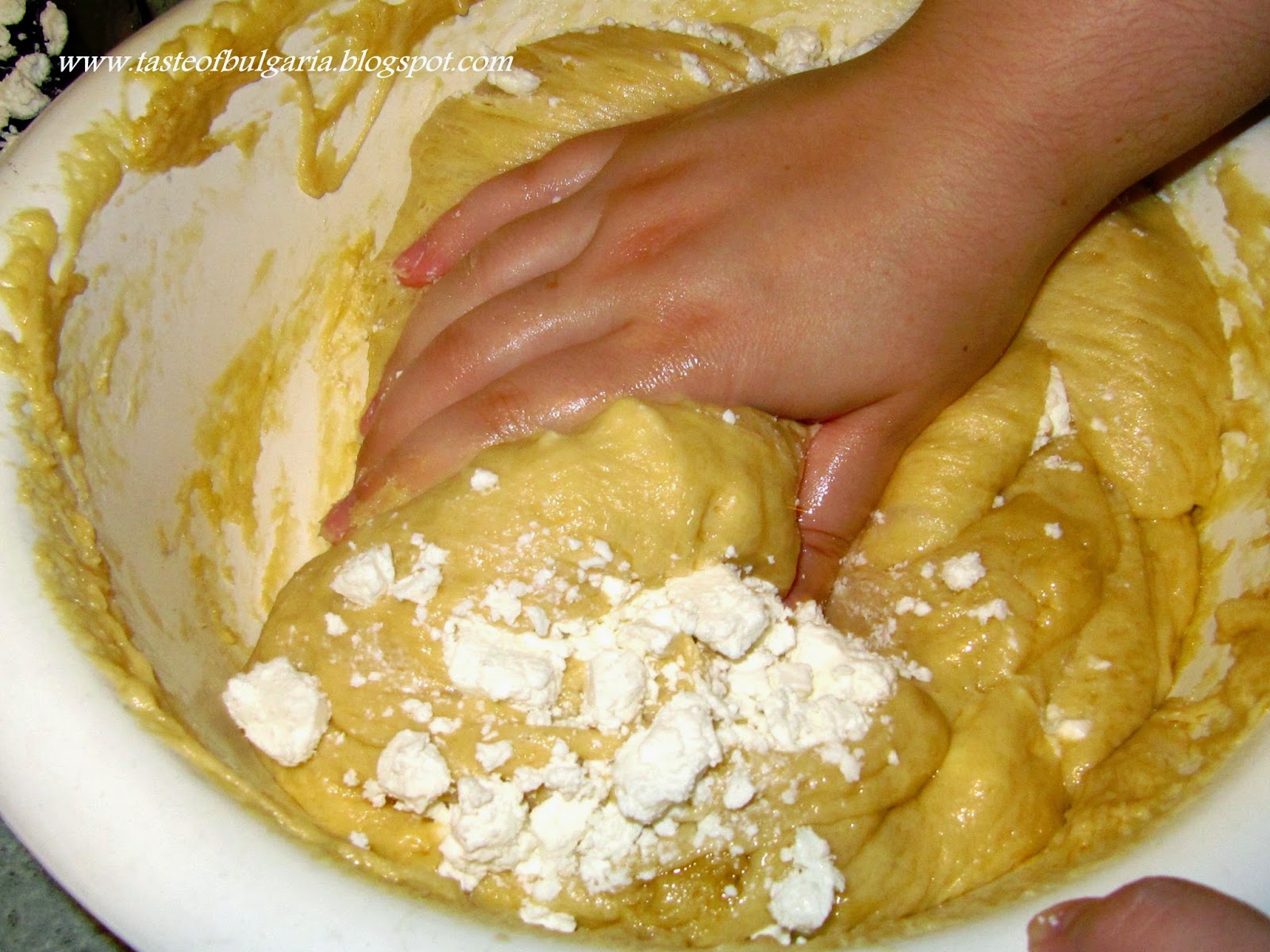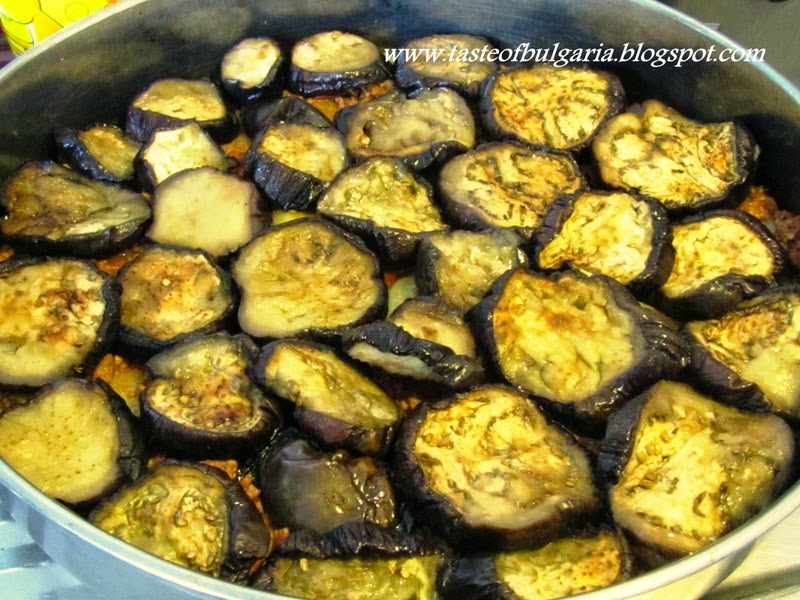TUTMANIK
Today I
decided to show a recipe for something different. The Bulgarian cuisine has
plenty of recipes for pastries and bakery dishes, all of which are delicious. I
am, in fact, a big fan of working with dough, so I love preparing them, I love
eating them, I love sharing them with others. This particular recipe is for
savory pastry called tutmanik. It is a delicious dish that can be eaten at any
time of the day. This recipe has plenty of versions, I am merely sharing the
one I love making at home.
Since the
preparation for this dish is time-consuming and a bit complex, the recipe will
be accompanied by plenty of pictures and a lot of instructions.
Ingredients:
For the
dough:
700g white
flour
4 eggs
280ml
vegetable or sunflower seed oil + 50ml for oiling the dough and the baking dish
14g dry
yeast
150ml 2%
yoghurt
Salt
For the
filling:
2 large
onions
1 spoon of
brown sugar
A pinch of
salt
1 teaspoon
of lemon juice
4-5 smoked
sausages
300g feta
cheese
For the
sauce:
2 eggs
400g
yoghurt
50g butter
1. Activate
your yeast by mixing it with 150ml water at room temperature, 1 spoon of sugar
and 1 spoon of flour. Mix very well until everything is incorporated. You can
even use a mixer. Place the bowl you used in a warm place and cover with
something. You can use another larger bowl full of hot (but not scalding!) water.
2. Sieve
your flour two, even three times. You need for there to be a lot of air in your
flour. Make sure all your ingredients are at room temperature.
3. Find a
suitable bowl or a dish you can use to knead your dough in. I don’t recommend
doing it directly on the table because the dough is quite soft and sticky. The
vessel you use needs to be spacious enough for you to move your hand
comfortably in it. Place 1/3 of your flour in the bowl you’ve chosen. Add salt
to taste (while taking into consideration just how salty the cheese you’ve
chosen is). Mix the salt well with the flour. Add all your liquid ingredients –
the eggs, the yoghurt, the oil and the yeast.
4. Begin
mixing – you can either use a mixer or your hand for this part, personally I
prefer using my hands all the way. At this point the dough is practically
liquid, do not be concerned, that’s normal.
5. Add
another third of the flour and start incorporating it into the mixture. You’ll
notice the dough thickening. Keep kneading.
 6. Begin
adding the final third of the flour. You don’t actually have to add all of it.
Depending on how liquid your yoghurt is and how large your eggs are, you might
not need the entire portion. Keep kneading. The end result should be very soft
and quite sticky but fully coherent dough.
6. Begin
adding the final third of the flour. You don’t actually have to add all of it.
Depending on how liquid your yoghurt is and how large your eggs are, you might
not need the entire portion. Keep kneading. The end result should be very soft
and quite sticky but fully coherent dough.
You can occasionally sprinkle (sprinkle, don’t pour – you don’t want all
that oil to be incorporated into your already quite oily dough) a little
oil on it so it doesn’t stick to your hands as much. Knead until it has become
silky smooth and elastic.
7. After
you’re done kneading, form the dough in a ball and either leave it in the same
dish you kneaded it in or in another suitable (and well-oiled) dish you’ll use
to prove it. Oil the top and cover it lightly with a plastic wrap. Cover the
wrap with a towel. Place the dish in a warm place for the dough to rise.
Personally, I just use my sink – I plug it, then fill it with hot (not
scalding!) water and place the dish in the water. Wait until the dough has
doubled, even tripled in size. You might have to add more hot water when the
one you already have begins to cool down.
8. While
your dough is rising, cut your onion into slices and sautee them in a pan,
adding the brown sugar, the lemon juice and the pinch of salt. Caramelize it
well and wait until all the liquid has boiled away.
Cut your sausages into
pieces. Get your baking dish and oil it, then sprinkle flour on the surface.Crumble your cheese.
9. Once the
dough has risen enough, remove the plastic wrap and get your cheese.
Divide your cheese in several portions. Sprinkle the first portion on top of the
dough, then press down, then carefully knead it until it’s incorporated. Do the same with the rest of the cheese until it’s fully incorporated into the dough.
10.
Organize your work space – place the onion, the sausages, the dough and your
baking dish within an arm’s reach. Oil the palms of your hands. You can use
gloves for this part, but you need to oil them as well.
11. Take a
handful of the dough and form a patty on the palm of your hand. Place a bit of
the onion on the patty, then add a piece of the sausage on top. Wrap dough
around the filling and form a ball with your hands. Place the ball in the
baking dish.
Keep doing this until you run out of dough and filling. Do not be
concerned if the balls begin to lose their shape in the baking dish because the
dough is so soft, we’ll prove the dough a second time anyway.
12. Once
again cover the dough with a plastic wrap and a towel and repeat the proving
process. Give it time to rise and fill your baking dish.
13. When
it’s done rising remove the plastic wrap and place your baking dish in a
pre-heated 50-60C oven. Let it rise some more for 15-20 minutes, then increase
the temperature to 200C.
Bake the tutmanik until the top turns golden brown.
Check whether it’s ready by sticking a wooden skewer in it – if it comes out
dry and clean then it’s ready.
14. At this
point we can do two different things – you can either smear a bit of butter on
top of it and cover with a aluminum foil for about 10-15 mins or we can add the
sauce and bake it some more. In case you wish to do the latter, follow the next
step.
15. Mix the
ingredients for the sauce in a bowl. Pour them on top of the tutmanik and
return it in the hot oven for another 10 minutes. Once you remove it from the
oven you can add the butter as well.
You can
serve the tutmanik with yoghurt or salad, it’s delicious either way! Bon
Appétit!


















































